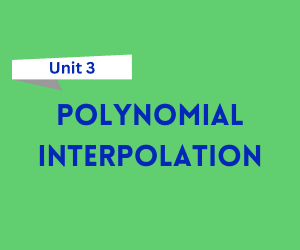
Free Download Polynomial Interpolation Notes in pdf – Bca 6th Semester. High quality, well-structured and Standard Notes that are easy to remember.
Click on the Download Button 👇
Polynomial Interpolation
Polynomial interpolation is a method of estimating values between known data points using a polynomial. Given a set of discrete data points, polynomial interpolation finds a polynomial that passes through all the points. It is widely used in numerical analysis, computer graphics, and engineering to estimate unknown values within the range of the data.
Key Points about Polynomial Interpolation
Definition:
- Polynomial interpolation involves finding a polynomial that passes through a given set of data points. The goal is to construct a polynomial
P(x)P(x)P(x) such that for each known data point
(xi,yi)(x_i, y_i), the polynomial satisfies
P(xi)=yiP(x_i) = y_i.
- Polynomial interpolation involves finding a polynomial that passes through a given set of data points. The goal is to construct a polynomial
Degree of the Polynomial:
- The degree of the interpolating polynomial is determined by the number of data points. For
nnn data points, the polynomial will generally have a degree of
n−1n-1n−1 to ensure it passes through all points.
- The degree of the interpolating polynomial is determined by the number of data points. For
Lagrange and Newton Methods:
- Lagrange Interpolation: Uses a weighted sum of basis polynomials, where each basis polynomial is constructed to be 1 at a specific point and 0 at all others.
- Newton Interpolation: Constructs the polynomial incrementally by adding terms based on divided differences, which can be more efficient in some cases.
Applications:
- Used for curve fitting, numerical integration, solving differential equations, and in various scientific computations.
- In computer graphics, polynomial interpolation is applied for smooth transitions, animation, and approximating curves.
Accuracy and Challenges:
- Polynomial interpolation can be prone to Runge’s Phenomenon when using high-degree polynomials, leading to oscillations or inaccuracies between points.
- For large datasets, polynomial interpolation might not be the best option due to the potential for overfitting.
Features of Polynomial Interpolation
Smooth Estimation: Polynomial interpolation provides a smooth curve passing through all the given points, making it useful for visualizing data trends.
Exact Fit: The polynomial always passes through the given data points, providing an exact fit for the known data.
Variable Complexity: The degree of the polynomial increases with the number of data points, leading to higher computational complexity.
Versatility: Polynomial interpolation can be applied to any dataset where values need to be estimated or approximated between known points.
Computational Efficiency: For smaller datasets, polynomial interpolation can be computationally efficient. However, for large datasets, its efficiency can decrease due to the complexity of higher-degree polynomials.
Features of Polynomial Interpolation
Smooth Estimation: Polynomial interpolation provides a smooth curve passing through all the given points, making it useful for visualizing data trends.
Exact Fit: The polynomial always passes through the given data points, providing an exact fit for the known data.
Variable Complexity: The degree of the polynomial increases with the number of data points, leading to higher computational complexity.
Versatility: Polynomial interpolation can be applied to any dataset where values need to be estimated or approximated between known points.
Computational Efficiency: For smaller datasets, polynomial interpolation can be computationally efficient. However, for large datasets, its efficiency can decrease due to the complexity of higher-degree polynomials.
FAQs on Polynomial Interpolation
Q1: What is the purpose of polynomial interpolation?
The purpose of polynomial interpolation is to construct a polynomial that accurately estimates or predicts values between known data points, ensuring a smooth curve that passes through all given points.
Q2: What is Runge’s Phenomenon?
Runge’s Phenomenon occurs when using high-degree polynomials for interpolation, leading to oscillations and inaccuracies in the approximated values, especially near the edges of the interval. This phenomenon highlights the drawbacks of polynomial interpolation in certain cases.
Q3: How do Lagrange and Newton methods differ?
- Lagrange Interpolation: Constructs the polynomial as a weighted sum of basis polynomials, with each basis polynomial corresponding to one data point.
- Newton Interpolation: Builds the polynomial incrementally by adding terms based on divided differences, making it more efficient when adding new data points.
Q4: Can polynomial interpolation be used for extrapolation?
Yes, polynomial interpolation can be used for extrapolation (predicting values outside the given data range). However, extrapolation is riskier as polynomials may behave unpredictably outside the data range, leading to inaccurate results.
Q5: What are the disadvantages of polynomial interpolation?
- Overfitting: High-degree polynomials can lead to overfitting, where the polynomial fits the given data points but behaves erratically between them.
- Computational Complexity: As the number of data points increases, the degree of the polynomial also increases, making the computation more complex.
Q6: What is the degree of the interpolating polynomial?
For n data points, the degree of the interpolating polynomial is n−1. A polynomial of this degree ensures that the curve passes through all the data points.
Q7: What is the practical use of polynomial interpolation?
Polynomial interpolation is used in applications requiring smooth curve fitting, such as in computer graphics for generating smooth paths or in numerical methods for approximating functions, solving differential equations, and predicting values in scientific data analysis.